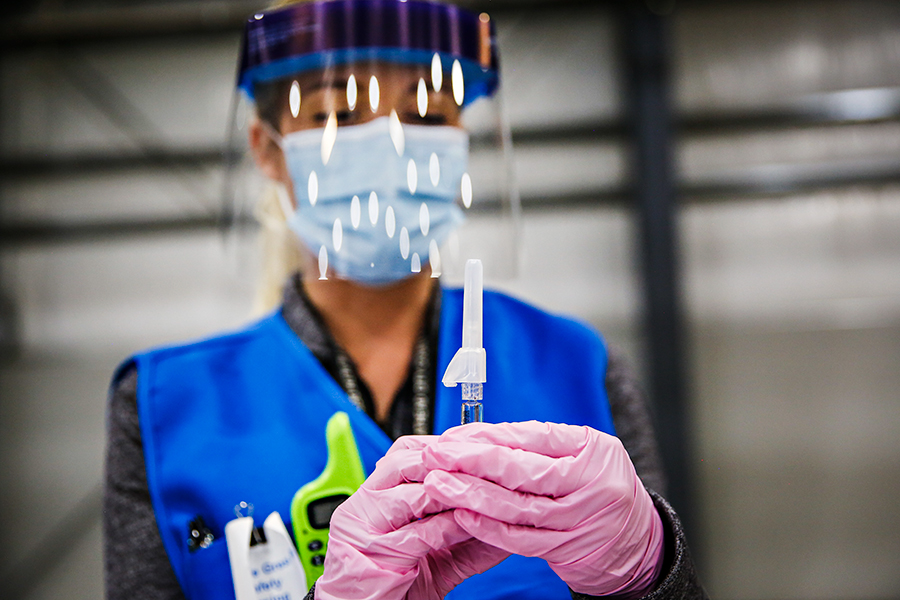Health Officials Prepare to Navigate Roadblocks When COVID-19 Vaccine Arrives
First doses of fast-tracked vaccines could be available by December, but it will be months before mass quantities are available, and a key question remains whether people will take it
By Andy Viano
At least one of the several COVID-19 vaccines being developed at record pace could be available in Montana before the end of the year, but health officials caution it will be much longer before large quantities are available and that the vaccine is only effective if an overwhelming majority of the population agrees to take it.
Pfizer Pharmaceuticals made international headlines earlier this month when the company revealed that its most recent testing of an RNA-based vaccine was more than 90% effective in immunizing patients from COVID-19. The company’s CEO called the announcement “a great day for science and humanity” and several other vaccines are also in the final testing phases. The welcome news means a finish line could be in sight even as the pandemic spreads faster than it ever has in much of the country, including in Flathead County.
In the Flathead, public-health officials and the health-care community have long been preparing for a vaccine’s potential arrival but plans are still fluid, in part because of how difficult deploying a vaccine for this particular virus will be. COVID-19 is so contagious that an indoor mass-deployment event where a large number of people would receive the vaccine at the same time is off the table, and the weather that comes with a Montana winter means an outdoor event is also unlikely. The Flathead City-County Health Department proposed the purchase of a mobile medical unit to bring the vaccine to the community, but that proposal was turned down by the Flathead County Commission, citing a fear that federal relief money may not apply to such a purchase.
Regardless of whether or not the mobile unit is discussed again by county officials, other options are possible for deploying the vaccine. Drive-thru testing like that used at a flu clinic at the Flathead County Fairgrounds last month has been discussed, and the head of the state’s immunization program said scheduling technology used to cycle people through a large-scale event without forcing them to come into close contact is also an option.
“Part of our planning is to figure that out, so some of our clinics and our local health jurisdictions have come up with some creative ideas,” Bekki Wehner, the bureau chief of the communicable disease control and prevention bureau at the Montana Department of Public Health and Human Services, said.
For the Pfizer vaccine in particular, one additional challenge is maintaining cold enough temperatures to store the drug. That vaccine must be kept at something like 80 degrees below zero, requiring the use of an ultra-cold freezer, the kind that is available at some larger hospitals and laboratories but rarely in more rural areas. Most of the vaccines in distribution, including the one from Pfizer, also require two doses before a person is fully protected, further pushing out the timeline for widespread vaccination.
“They’re already starting to do some of that logistic planning and making sure that we have those freezer units,” Dr. Jeffrey Tjaden, an infectious disease doctor at Kalispell Regional Healthcare, said. “The hospital is definitely engaged with the county and the state and then the federal government.”
However the vaccine is stored and distributed, the first people who will get doses come from the front lines. Wehner said the list would likely start with health-care personnel, then include essential workers like law enforcement and other first responders. The next wave, whenever enough doses are available, could reach residents of long-term care facilities and those with underlying health conditions.
Wehner speculated it could be April or May before anyone who doesn’t fall into a high-risk category would be able to receive the vaccine but added that even then it’s not a given that a community will be completely safe.
“The bigger issue is (making sure) that everyone feels confident getting the vaccine,” she said.
The data from Pfizer’s tests will be well-vetted by the federal government before it is approved for distribution, and by that time more data should be available, which Wehner hopes will make people more comfortable taking the vaccine. Tjaden agreed that getting full buy-in on a COVID-19 vaccine could be a challenge but said he would not hesitate to get the vaccine himself.
“What we find is that most people actually do have confidence in vaccines and they just need that reassurance,” Wehner said. “When the time comes, we feel confident we’ll have enough information and enough data that people will be confident in taking it.”